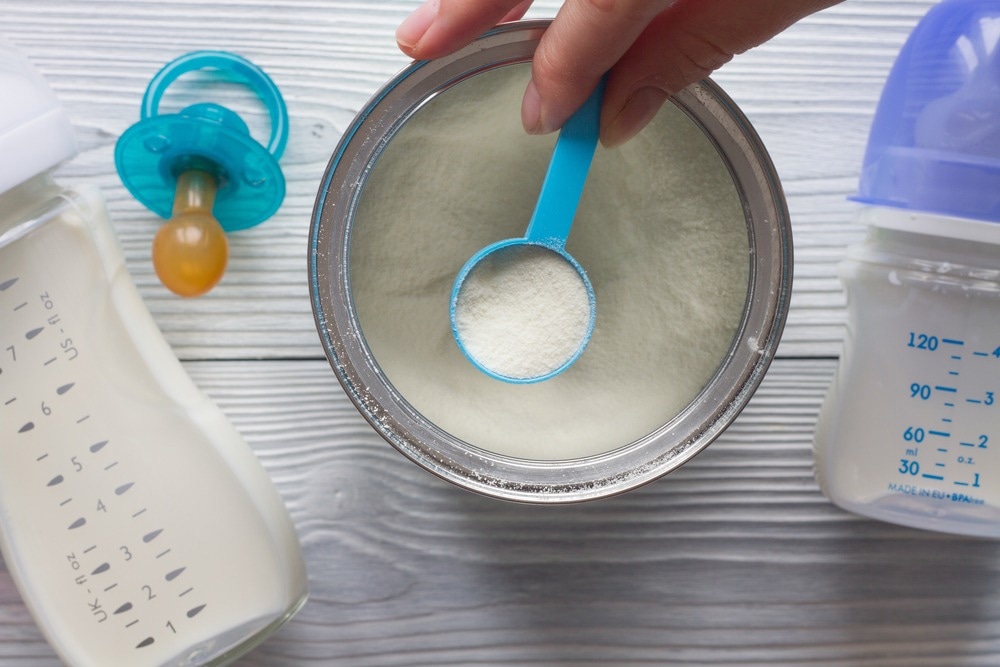Dairy products, such as milk formula, powdered milk, and infant formula, are generally not sterile and could be contaminated with various bacteria and pathogens, particularly Staphylococcus aureus (S. aureus). Therefore, developing a facile detection system for these pathogens is necessary to maintain food safety standards.

Study: Naked-eye detection of Staphylococcus aureus in powdered milk and infant formula using gold nanoparticles. Image Credit: 279photo Studio/Shutterstock.com
A pre-proof paper from the Journal of Microbiological Methods describes a novel method capable of tackling this issue. This research focuses on the fabrication of a novel biosensor based on gold nanoparticles for naked-eye detection of S. aureus in various dairy products like milk formula, powdered milk, and infant formula.
Staphylococcus Aureus: An Extremely Harmful Pathogen
Staphylococcus aureus, sometimes known as "golden staph," is an extremely adaptable human and livestock bacterium that has become a serious public health problem owing to its high antimicrobial resistance. It is a Gram-positive pathogenic bacteria found in roughly thirty percent of the populace on skin surfaces and mucus. It is commonly found in dirt, liquids, and on contaminated surfaces.
S. aureus can cause a variety of diseases in humans and livestock, including simple skin conditions, chronic intestinal infections, and fatal disorders. It has a significant potential for milk formula contamination because it can create seven separate heat-resistant toxins capable of withstanding the sterilization step of milk formula production.
Dairy items, including milk powder and milk formula, are considered transmitters for S. aureus infections in humans. The contaminants may enter the production process during transportation and storage if hygienic milking procedures are not strictly followed or via infected milking apparatus.
Cross-contamination by S. aureus during milk processing has been widely documented for dried infant formula, posing a major health hazard to babies with immature immune systems. As a result, effective detection of S. aureus is critical for preventing bacterial spread in newborn formula and lowering hazards connected with public safety and food stability.
Limitations of Current S. Aureus Detection Methods
The conventional approaches for detecting S. aureus are culture-based. These include specimen processing, enhancement, colony screening, counting, and a verification test. Traditional procedures, although precise, are time-consuming and require multiple days to produce any results.
MALDI-TOF mass spectrometry, polymerase chain reactions (PCR), and enzyme-linked immunosorbent assays (ELISA) are some examples of molecular techniques used for S. aureus detection. Despite their ability to provide results in a matter of hours, molecular approaches are not frequently employed since they need expert personnel, costly laboratory equipment, and well-isolated specimens.
Furthermore, molecular approaches can produce misleading negative results owing to the repressive activity of milk proteins on DNA polymerase and milk fat disruptions in DNA separation.
Gold Nanoparticles: The Future of S. Aureus Detection
Nanomaterials have grown in importance as novel techniques for assessing food security during the previous decade. Gold nanoparticles (AuNPs) are especially promising because they can easily fulfill international food safety criteria.
Gold nanoparticles can be readily synthesized and characterized with biomolecules because of the localized surface plasmon resonance (LSPR) effect, enabling naked-eye detection of intact microbial species. LSPR heavily depends upon refractive indices, shape, and inter-particle spacing of gold nanoparticles.
These parameters can be modified upon the accumulation of gold nanoparticles, inducing a color change in the solution and allowing naked-eye identification of bacterial cells in dairy products such as milk formula, powdered milk, and infant formula.
Highlights and Key Developments of the Current Study
In this study, the researchers created and optimized an aptamer-based LSPR immunoassay based on gold nanoparticles to detect Staphylococcus aureus in milk formula, powdered milk, and newborn formula. Aptamers are narrow single-stranded oligomers that use gold nanoparticles to identify and bind particular protein targets.
Dairy products, especially milk formula, are among the most difficult food materials for colorimetric assays because they include ingredients that significantly interact with gold nanoparticles and compromise the assay results. An excellent LSPR sensor performance in milk formula, powdered milk, and infant formula was established by executing a single extra step before the final analysis.
According to the observed limit of detection, the as-prepared aptasensor is appropriate for assessing dairy samples for S. aureus, particularly infant formula, since the infectious dosages were found to be more than 1010 cells.
These results show that the simple sensing approach used in this work may allow for the quick and naked-eye identification of S. aureus in milk products.
Reference
Marin, M. et al. (2022). Naked-eye detection of Staphylococcus aureus in powdered milk and infant formula using gold nanoparticles. Journal of Microbiological Methods. Available at: https://doi.org/10.1016/j.mimet.2022.106578
Disclaimer: The views expressed here are those of the author expressed in their private capacity and do not necessarily represent the views of AZoM.com Limited T/A AZoNetwork the owner and operator of this website. This disclaimer forms part of the Terms and conditions of use of this website.